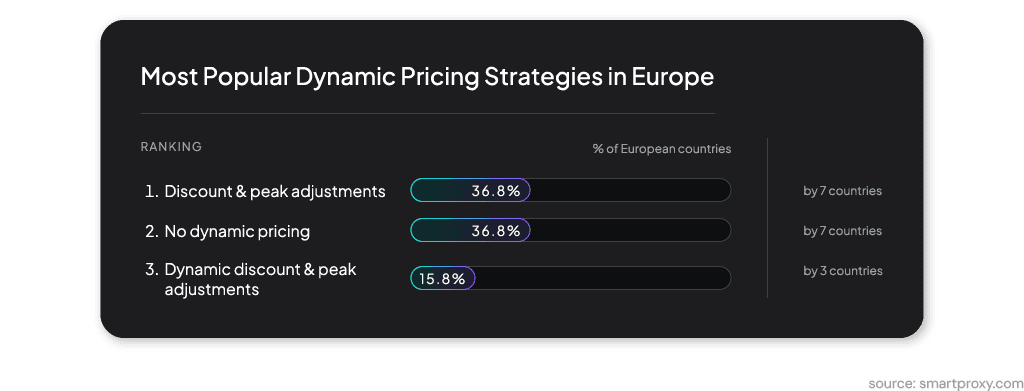Europe eCommerce: Strong in Experience, Weaker in Dynamic Pricing
While European countries dominate the eCommerce Maturity Index by providing the most holistic eCommerce experience, they’re less advanced in adjusting their pricing strategies according to the buyer’s demand, peak shopping days, and competitors.
Lagging dynamic pricing usage in Europe
Looking at the top 10 in the Dynamic Pricing Index, only 3 out of 10 countries are from the European continent, compared to 8 out of 10 in the eCommerce Maturity Index.
The countries that make the cut are Italy (#4), Hungary (#6), and the United Kingdom (#9). This highlights a significant disparity between general eCommerce maturity and the adoption of advanced pricing strategies within Europe.
European eCommerce businesses use less advanced pricing techniques such as discount and peak shopping period adjustments. This strategy is employed by 36.8% of businesses in 7 European countries. A further 15.8% utilize dynamic discount and peak adjustment, involving 3 EU countries. Surprisingly, another 36.8% of businesses show no patterns indicative of dynamic pricing usage at all.
This reliance on traditional pricing strategies over dynamic pricing suggests that many European eCommerce businesses may miss out on opportunities to optimize their pricing in response to real-time market conditions.
The importance of dynamic pricing
Dynamic pricing is a strategy of adjusting prices in real time based on various factors such as market demand, competitor pricing, and other external conditions. This approach can substantially enhance the eCommerce business's ability to respond to market changes and customer behavior.
- Implementing dynamic pricing can lead to revenue increases. By adjusting prices based on demand fluctuations, businesses can capitalize on high-demand periods without losing customers during low-demand times. This flexibility maximizes revenue potential by setting prices that customers are willing to pay at any moment.
- Dynamic pricing enables eCommerce businesses to maintain competitiveness in a rapidly changing market. Real-time price adjustments in response to competitors' pricing strategies ensure a business can offer attractive prices without sacrificing profitability. This helps attract price-sensitive customers and retain existing ones by providing consistent value.
- Price adjustments in line with market dynamics can enhance customer satisfaction and loyalty. Customers who perceive that their favorite brand offers fair and competitive prices are more likely to return for future purchases. This trust in pricing strategies can lead to higher customer retention rates and positive word-of-mouth referrals.
Benefits beyond the demand side
While providing the best customer experience for some businesses is the ultimate goal, dynamic pricing also has significant advantages for supply-side management. eCommerce platforms can manage excess inventory more efficiently by adjusting prices based on stock levels. For instance, lowering prices during periods of high stock can expedite sales and reduce warehousing costs, while higher prices during low stock periods can prevent stockouts and maintain profit margins.
Dynamic pricing can also contribute to overall cost reduction. Efficiently managed stock levels mean lower warehousing costs, less capital tied up in unsold inventory, and reduced need for markdowns on unsold goods. These savings can be reinvested into other areas of the business, driving further growth and innovation.

Bottom line
European eCommerce businesses are at the forefront of providing a holistic eCommerce experience, yet there’s room for growth in adopting dynamic pricing strategies. By embracing more advanced dynamic pricing methods, these businesses can greatly increase their revenue and competitiveness and improve customer satisfaction.
European companies should consider integrating dynamic pricing into their strategies to fully leverage the benefits of real-time price adjustments, ensuring they remain competitive and profitable in an ever-evolving market.
Get all the insights on user experience and dynamic pricing usage. Continue exploring the eCommerce Maturity Index.
About the author

Dominykas Niaura
Technical Copywriter
Dominykas brings a unique blend of philosophical insight and technical expertise to his writing. Starting his career as a film critic and music industry copywriter, he's now an expert in making complex proxy and web scraping concepts accessible to everyone.
Connect with Dominykas via LinkedIn
All information on Smartproxy Blog is provided on an as is basis and for informational purposes only. We make no representation and disclaim all liability with respect to your use of any information contained on Smartproxy Blog or any third-party websites that may belinked therein.







